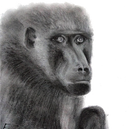Communication and collective movement in meerkats

Vocalizations play a key role in the coordination of movement in many social species, particularly those that form stable social groups. By varying the calls they produce, individuals in groups may flexibly, dynamically, and even strategically shape their interactions with others. How does such signaling behavior affect the dynamics of collective movement?
Meerkats are an ideal system in which to address this question. These cooperatively breeding mongooses live in stable groups that travel long distances as a group each day while foraging. Vocal communication plays a key role in movement coordination, with meerkats giving several different calls associated with maintaining cohesion and coordinating travel.
In collaboration with the group of Marta Manser at U Zurich and the Kalahari Meerkat Project, we are using multi-sensor collars to monitor the movements, calls, and behaviors of entire groups of meerkats. We use these data to reveal how individuals make decisions and how these decisions scale up to produce collective movement patterns.
Combining movement and vocalizations
Video shows one hour of combined movement and acoustic data for all seven meerkats within the "Hakuna Matata" group, from 10 - 11 am on August 25, 2017 in the Kalahari Desert, South Africa. Colored dots show the locations of meerkats, with markers popping up around them when the meerkat calls. The marker type indicates the type of call - see legend for details. For example, "CC" (gray circles) represent "close calls," a call commonly given by meerkats while foraging and thought to be associated with maintaining group cohesion.

What does a foraging meerkat sound like?
Click below to hear a 15 second clip from one of our meerkat collars. The meerkat gives 4 close calls during the clip, which are marked with dotted lines in the corresponding waveform and spectogram image.




